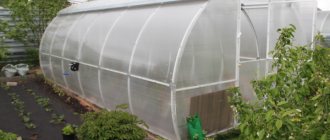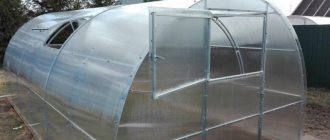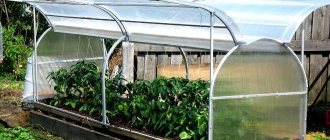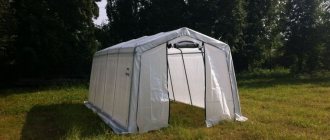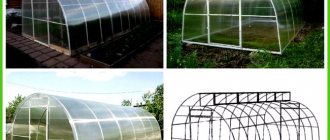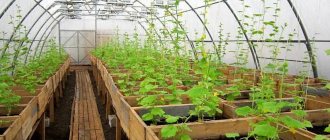In the harsh conditions of the Siberian climate, growing crops in open ground becomes significantly more difficult, and in some situations becomes completely impossible. Therefore, those who want to eat not imported, but their own vegetables and berries, have to adapt and look for ways to protect plants from cold, wind and night frosts. One of the most effective solutions to all these problems was the Sibirskaya greenhouse from. By the way, a number of other companies are engaged in the production of such greenhouses, but the dimensions and characteristics are the same for all.
Greenhouse "Sibirskaya"
What is the Siberian greenhouse?
Particular endurance is required for those greenhouses that remain under a thick layer of snow throughout the winter, and the summer resident is deprived of the opportunity to come to his site to free the greenhouse from snow oppression and clear the perimeter.
It is in such cases that a greenhouse belonging to the “Siberian” category, which has a frame with a significant margin of safety that is not susceptible to harsh winter conditions, may be most suitable.
The maximum strength of Siberian greenhouses and their high-quality ability to withstand frost and other loads distinguish these structures.
Such greenhouses are perfect for any summer resident for growing crops and for any person for whom the summer house is a place for relaxation in the fresh air, and not a garden, because such a design can act as a wonderful pavilion for a swimming pool or a very spacious utility unit.
How to properly arrange heating?
And finally, the last thing you need to figure out in advance is heat. Of course, a greenhouse for Siberia with its separate heating can, as people say, cost a pretty penny - and therefore it is much more rational to attach it to a house that already has a boiler and all the necessary automation. And the heating itself in a Siberian greenhouse must be twice as powerful as in a house, oddly enough.
Related articles: How to make a stove for heating a greenhouse: a review of the 5 best homemade products + Heaters for greenhouses - infrared, gas, cable and others
Another great budget idea for a Siberian greenhouse is a solar air conditioner, when the water in the greenhouse is heated by the sun during the day and gives off a lot of valuable heat at night. But it will take a lot of work to implement it.
Don’t believe that something can grow in a greenhouse when there is two meters of snow outside? Here you are:
Taking into account the climatic specifics of Siberia
Surrounded by the harsh demands of the Siberian climate, the difficulty of growing any agricultural crop, and even in open ground, is high. And sometimes this difficulty easily changes to impossibility - such situations are also not uncommon.
- For this reason, for those people who plan to eat vegetables and fruits grown on their own plot of land, it is better to find in advance ways to protect the grown vitamins from seasonal cold snaps, constant gusts of icy winds and winter frosts.
- And to face truly severe cold weather, you don’t have to live in Siberia. In the European part of Russia, the cold in winter can also be quite severe, and the winds can be as icy as beyond the Ural ridge.
The greenhouse, called “Siberian”, is a high-quality solution to the difficulties that any summer resident faces every winter.
Marking the site and creating a foundation
Considering that Siberian soil freezes 2–3 m deep, installing a foundation is advisable. This will provide the plant root system with a comfortable temperature regime. Choose an area that is well lit and flat or slopes to the south. Avoid areas that will be permanently shaded by buildings or tree canopies.
The long side of the structure should be placed in the north-south direction. On the north side it should be protected from the wind by some natural barriers. The future area for the foundation must be cleared of weeds, small debris and leveled. Mark the area of the future greenhouse with pegs, tape measure and construction cord.
Did you know? The greenhouse does not have to be installed in constant sun. Most plants prefer bright light in the morning and shade in the afternoon. The shade also creates coolness and prevents the air inside from overheating.
Also prepare tools and materials to create a foundation:
- building materials - sand, concrete, reinforcement;
- tools for construction - a container for preparing mortar, a concrete mixer, a trowel, buckets, a drill, a grinder and discs for it, a building level and a tape measure, a shovel.
There are several ways to secure a greenhouse to the ground. The simplest is to drive metal pins into the ground at regular intervals and attach the base of the structure to them. The most difficult thing is to make the foundation, as for any building. Greenhouse layout diagram.
For a regular foundation:
- They dig a pit to fit the size of the structure.
- Install the formwork, checking its level.
- Make a sand and gravel cushion.
- The reinforcement is installed and poured with concrete (1 part cement is mixed with 3 parts sand and water is added to obtain a plastic mass).
- After 2 weeks, the formwork is removed and the installation of the greenhouse on the prepared base begins.
Which is the best greenhouse to use in winter?
The harsh Russian winters are by no means the reason why a summer resident is advised to give up growing vegetables and herbs on his plot. Structures with a polycarbonate coating are now actively used in any Russian region, and not just in Siberia.
For example, in the south, where the climate is much milder due to the presence of warm seas, grapes are actively grown in greenhouses.
- But on an industrial scale, such greenhouses are not very actively used, therefore their sizes usually correspond to the size of individual summer cottages and farmlands.
- And polycarbonate, used for the construction of greenhouse structures, is distinguished not only by its durability, but also by other positive characteristics, which can be discussed in more detail.
Specifications
- Siberian greenhouses are made of high-quality galvanized pipes, the square cross-section of which is twenty by twenty millimeters, and the wall thickness is one millimeter.
- The strength of the structure is also ensured by the cross method of fastening its parts.
- Siberian greenhouses have an arched frame. The walls of the structure, for the cladding of which polycarbonate is used, have four through openings - two doors and the same number of vents.
- These structures can be installed both on the foundation and on the ground. If installation is carried out on the ground, T-shaped legs are used.
- Assembly and installation of the frame requires the participation of no more than two people. Polycarbonate is also quite easy to install.
- Siberian greenhouses make it possible to grow early vegetables, flowers, seedlings and other crops of agricultural importance.
- These structures can change their length using special devices - modular inserts.
- The polycarbonate with which Siberian greenhouses are sheathed has a standard thickness of four millimeters. The building material is also endowed with the ability to protect the insides of structures from ultraviolet radiation.
- The polycarbonate used for structures of this type has a ten-year guarantee.
- The warranty period for the operation of the greenhouses themselves is fifty years.
Homemade greenhouse
Advantages of polycarbonate greenhouses
Each polycarbonate sheet in the process of constructing a greenhouse has a truly impressive list of positive characteristics:
Weight
Polymer plastic has a significantly lower weight compared to other materials with similar properties - with a sheet thickness of 2-12 mm, its weight will be 2.4 - 14.4 kg.
This indicator makes it possible to build a roof structure that has an extremely low specific gravity, which seriously reduces the cost of the project and provides additional opportunities to use your imagination when creating the most suitable form of greenhouse.
Light transmittance level
It is practically no less than that of glass (more than 90%). At the same time, it is much more susceptible to ultraviolet radiation, which contributes to the wear of this material.
To avoid rapid wear of polycarbonate, a special visually invisible coating is applied to it, which is capable of fully protecting the polycarbonate for 10-15 years.
Chemical resistance
A significant part of the varieties of aggressive compounds are incapable of having a detrimental effect on the polymer, even under conditions of prolonged influence.
Thermal insulation properties
The polymer has high-quality thermal insulation properties, which allows it to be used in the construction of a greenhouse without additional insulating materials.
Acceptable cost
Thanks to the fairly moderate cost of polycarbonate, every summer resident has the opportunity to replace failed greenhouse elements.
Availability for adding elements to the design
In particular, it is quite possible to install an additional heating system and even water supply for year-round irrigation in a greenhouse with a polycarbonate frame, which will make it possible to use the greenhouse all year round, and not just in cold weather.
Preparatory work
Preparing for the construction of a winter (year-round) greenhouse with your own hands includes planning, preparation of materials, preparation for heating installation and arrangement of the foundation.
Planning
There are many options for winter greenhouse designs. They can be a traditional, quadrangular shape in the top view, but they can also be hexagonal , they can be of different heights , ventilated differently, etc. The easiest way is to take as a basis the design of a quadrangular (sometimes they say four-walled) greenhouse , and here's why:
- personal plots and vegetable gardens usually have a quadrangular shape; by arranging the greenhouse according to the shape of the vegetable garden, you rationally use the space ;
- A four-wall greenhouse design for winter growing is simpler . Especially when glazing or stretching film;
- To service such a greenhouse, you can draw a single path in the middle, along which pipes for irrigation, etc. will be directed. That is, it is easier to operate .
Hexagonal (octagonal, decagonal) greenhouses usually have modest dimensions and the advantage that the hexagon has a more favorable ratio of area and perimeter, hence less heat loss , but the complexity of the design and the complexity of operation, the limitation in size makes such greenhouses more of a work of art than a means to earn money or grow plants for food. Therefore, we will consider a quadrangular greenhouse.
Fig.3 Hexagonal greenhouse
It should be oriented from north to south, it is best to make the roof gable , and install additional supports so that the structure does not collapse under the weight of snow. If the frame is factory-made and the cross-section of the greenhouse has the shape of an arch, this is even better - the snow will slide off on its own.
The place should be level, the soil should be sandy . If it is clayey, you need to make a cushion of sand, and on top - a layer of fertile black soil.
Ventilation must be carried out regularly during the warm season , otherwise the plants will die from the heat. This means that this function needs to be included in the design. Firstly , the greenhouse must have two doors at opposite ends to create a draft when they are opened simultaneously. Secondly , if the greenhouse is more than 10 meters in length, it is desirable that it also have opening windows . Windows can be in the side walls, the ceiling, next to or above the doors. The higher the windows, the better.
Materials
Here , the stronger, the better . A steel angle or pipe is best. A factory frame made of galvanized iron is suitable. Bolt together.
Worse - timber, board or poles. It is better to fasten wood with self-tapping screws; nails are often pulled out by the wind, especially when the wood begins to collapse.
It is advisable to paint non-galvanized iron so that it rusts less, and treat wood with an antiseptic to prevent fungi or insects from infesting it.
Foundation structure
This mandatory part of the winter greenhouse must reach such a depth where the ground no longer freezes . The foundation may consist of cinder block or concrete. It must be insulated on top with waterproof material (tar paper) so that moisture does not rise higher.
On the foundation there must be a plinth , which is built from the same cinder block or brick. In this case, the floor of the greenhouse can be lower than the level of the surrounding soil , i.e., year-round greenhouses made with your own hands are, as it were, dug into the ground for better heat retention.
Heating preparation
For large greenhouses, the best heating is water , like in a house. This will allow the heat to be evenly distributed. But this requires a lot of money, materials and labor, so it will be easier to make several ordinary potbelly stoves . For a potbelly stove to be more efficient, the pipe from it should not go vertically upward. Instead, make 5 meters of pipe at a slight angle (up to 10 degrees), and then connect it to a vertical pipe.
Be careful that there are no smoke leaks at the joints - it is harmful to plants because it contains sulfur oxides.
Fig. 4 Example of heating in a winter greenhouse
There are also infrared gas burners , which will serve as an additional source of heat. But they need to be screened from the ceiling and from plants. It is best to place such a burner inside a large pipe, open on both sides. The combustion products of natural gas are almost harmless to plants , unlike the combustion products of wood and coal.
Siberian greenhouse made of polycarbonate (design)
It often happens that farm owners leave their plots for the winter, and accordingly, they lose the opportunity to constantly monitor their greenhouse.
If at this time some negative incident occurs with the greenhouse, for example, the coating cannot withstand the load of snow or the polycarbonate that has been used for a long time becomes unusable due to the constant ultraviolet influence on it, some damage will occur that cannot be corrected immediately.
- For this reason, it is recommended to strengthen the structure and install it on a reliable foundation.
- This will directly contribute to the fact that the greenhouse will be able to withstand much more severe loads.
- The reinforced structure will undoubtedly be able to protect the future harvest from all kinds of problems.
For example, galvanized arcs with special jumpers or supports can be added to the frame of a polycarbonate greenhouse. This will make it much more durable and reliable.
Of course, additional elements will significantly increase the total weight of the entire structure, so it will need to be installed on a concrete foundation. Assembling the greenhouse by specialists will not take a long time, and the summer resident will always know that his harvest will ripen on time.
Mandatory requirements
Of course, the design of a winter greenhouse for growing vegetables all year round with your own hands should differ from the design of a regular greenhouse, especially from the design of a covered bed or greenhouse.
A winter greenhouse must have a foundation . Moreover, its depth should be greater than the depth of soil freezing in a given area. The frame of a winter greenhouse should be more durable and consist of more reliable materials.
This is especially true for the roof, because in winter snow can fall on it, sometimes accumulating up to several tons. Fig. 2 Winter gable greenhouse
The covering material may also be different . For the same reasons: the film can stretch and break through under a huge mass of snow. Ice, which is formed as a result of melting snow and its subsequent freezing, is especially dangerous for the film. Glass in this sense is much better and safer. It should also be taken into account that one layer of covering material is not enough : such greenhouses are usually two-layer. If the covering material is glass, then this is also a huge load on the frame.
How to make a winter greenhouse warm yourself? A mandatory requirement is the presence of heating in the greenhouse . Moreover, if the greenhouse is long (more than 15 meters), most likely you will have to install not one stove, but two or even three.
And of course, lighting. In winter, plants will definitely experience a lack of light, especially in December, when short days overlap with cloudy weather. The design will definitely have to provide space for light sources .
